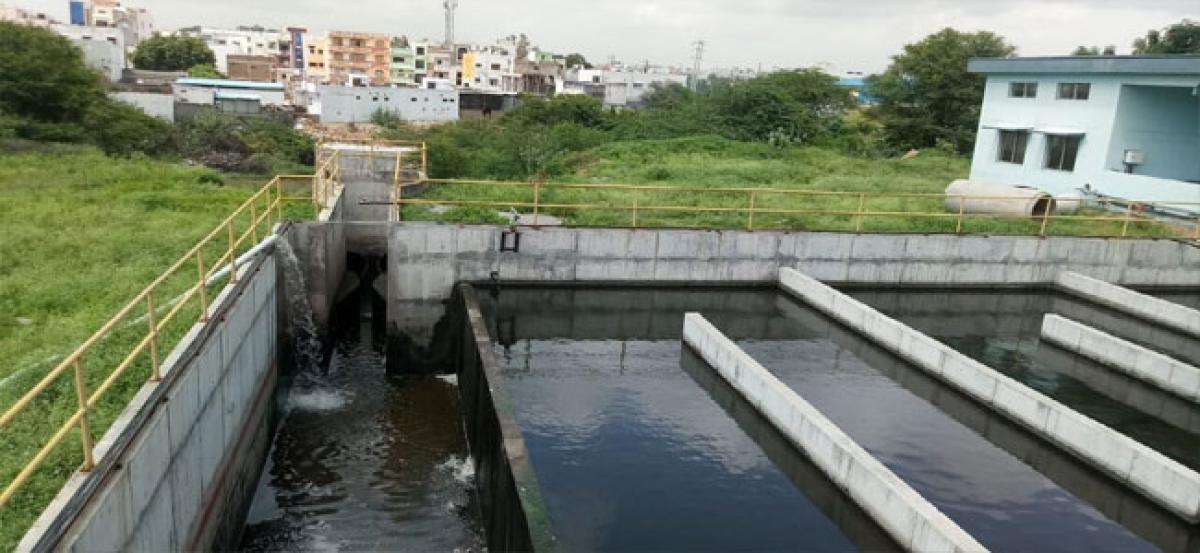Live
- 15 Years of Transformation: Oakridge International School, Bachupally Celebrates Founder's Day
- Takshasila celebrates annual day
- 3 months after opening, Morampudi Flyover remains incomplete
- Skill enhancement session organised for school teachers
- Tribal Ashram school girl students fall sick again
- Grand finale of Innovation marathon begins at IIT Tirupati
- Ensure no inconvenience to bus passengers: MLA
- Being overweight surpasses smoking as Australia's leading health risk
- Rush of Devotees at Tirumala normal, to take six hours for darshans
- Thiruvannamalai turns a major revenue earner for RTC
Just In

The futility of Sewage Treatment Plant STP has come to the fore In spite of the Hyderabad Metropolitan Water Supply and Sewerage Board spending Rs 2 cr per month, the water quality is abysmal
Hyderabad: The futility of Sewage Treatment Plant (STP) has come to the fore. In spite of the Hyderabad Metropolitan Water Supply and Sewerage Board spending Rs 2 cr per month, the water quality is abysmal. In just 8 km of its 40 km course across the city, river Musi has turned into a nala consisting of sewerage and industrial pollution. Murky waters of Musi are on a higher level of every norm of pollution scale. Untreated sewage is one of the major reasons of river pollution.
The river is running excessively low on oxygen as Biochemical Oxygen Demand (BOD) scale defines Musi as gravely polluted river with numbers reading 250mg/L while the normal value is between 3 and 5 mg/L. Higher BOD numbers means very little oxygen is available to aquatic life. Shockingly enough, the elevated BOD numbers comes from the river flowing just 8 km within of western ORR there lies the first sewage treatment plant (STP) of Attapur which claims treating 51 Million liters a day (MLD) originally treats only 23 MLD of sewerage.
“It is because the intake pumps are non-functional and are in a need of repair, tender has been called. We shall have them repaired by the second week of September,” said Hyderabad Metropolitan Water Supply and Sewerage Board (HMWSSB) Director Revenue and unaccounted for water (UFW), B Vijay Kumar Reddy. “Amberpet STP holds the capacity of treating 339 MLD where only 226 MLD of sewage is being treated.” reads a report published by International Journal of Research Sciences and Advanced Engineering. About 2 crore rupees are being spent every month to sustain STP in the city.
As per the official chart at Attapur STP treats less than half of sewerage in contrast with its capacity 23 MLD is being treated here the city generates more than 1,440 MLD of domestic sewage every day. “City does not even treat 30 per cent of sewerage which is being generated in the city, although the officials claim 50 per cent,” said environmentalist, Dr BV Subba Rao. He added, “There is no information or communication between the departments of Water and Sewerage, Pollution Control and Municipal Corporation boards in the city leaving no control over buildings and construction sites. As the city grows disproportionately sewerage also grows, and there are no plans in city to maintain sewerage flow, no water infrastructure is being discussed. For this reason the water is being diverted into low land areas eventually running into lakes and river bodies.”
Water pollution is usually measured in several parameters like chemical oxygen demand (COD) which determines the scale of oxygen to decompose both organic and inorganic compounds. COD of Musi is 384 mg/L which defines it as sewage quality water, however it is brought down to COD 36mg/L in Attapur thereafter treated water is released back into Musi. “Total Dissolved Solids (TDS) where Musi near Pratapa Singaram village, exit point of Musi from Hyderabad counts 2050 mg/L.” reports the Journal of Environmental Science, Toxicology and Food Technology.
Similarly, the quality of Musi is deteriorated when it reads on the scales of Total Suspended Solids and Ph levels of the water, most importantly indulgence of bacterium Ecoli a bioterrorism agent which also holds a bad reputation for causing scores of diseases in human beings. Dr Subbaro said “E.coli is just an example, there are many other invisible microbial bacterium which are not yet counted as there are no microbial indicators in any of the STP’s in the city.” Dr Subbarao says, “Treating the sewerage from drains itself is needed, STPs are very expensive.”
BY Mayank Tiwari

© 2024 Hyderabad Media House Limited/The Hans India. All rights reserved. Powered by hocalwire.com







